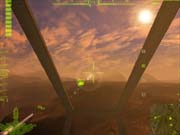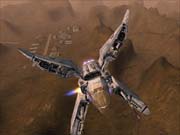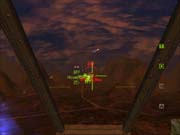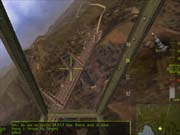Simulations with a science fiction theme haven't exactly been flying off the shelves in the last couple of years, in spite of the buzz surrounding last year's Crimson Skies and MechWarrior 4. And other than a few notable blips, hard-core flight sims have also largely disappeared off the radar in the past year or so. Echelon, a futuristic air-combat game developed by Russia's Buka Entertainment, combines elements from both science-fiction-themed games and traditional flight simulations. Instead of skirmishes in deep space, you pilot futuristic aircraft over beautiful alien worlds, battling both air and ground targets in fast-paced battles. Yet despite its promising premise, a host of problems really hurts what could have been a fine game.

Echelon's futuristic timeline begins with a massive civil war that throws the sprawling Galactic Empire into chaos and eventual collapse. Peace is restored as the Galactic Federation is formed, giving rise to a period of prosperity and expansion. As the Federation reaches outward to ever more remote areas, it comes in contact with a race known as the Velians. When the Federation learns of the Velians' null-t (null-transport) technology, it's quickly integrated into the economic fabric of Federation life, allowing rapid transit and trade. Unbeknownst to the Federation, the null-t stations are Trojan horses that quickly become nearly invincible bases of operation for the Velians as they attack the Federation.
In the single-player missions, you take the role of a fresh cadet out to help save the Federation from its new nemesis. That's not an uncommon scenario in a science fiction story, but when handled with skill, it can be effective. However, in Echelon, there's little sense of involvement with the story since you don't really get to know or care for any characters. Despite some beautiful cutscenes, the gameworld isn't distinctive or memorable. You don't feel like you're fighting for someone or something; you just fight because that's what the game is about.
The missions are scripted so that they largely play the same way each time. No matter what you do, enemies will appear at the exact same time and place, or your wingmen will inexplicably rush ahead just to get killed, leaving you alone against impossible odds. Some missions are outrageously hard, while others are too easy, and a number of them include tediously long escort segments with no action. Even with the time acceleration option activated, these missions still drag on. Such flaws sharply reduce the game's overall sense of excitement and replay value.

An anemic skirmish mode doesn't help much, though multiplayer can be exciting and offers deathmatch, team deathmatch, and a mode where you try to capture and hold ground bases. Unfortunately, the only way to join a multiplayer game is to seek out and manually enter a server's IP address. Also, the game will sometimes spawn your fighter right in front of a mountain, resulting in an unavoidable, fiery wreck.
A series of tutorials does a good job of helping you master the numerous controls and the somewhat unusual flight model. Many of the standard trappings of modern jet combat sims are present, such as a HUD with a scrolling altimeter, an airspeed indicator, and a multifunction radar and targeting system. The 14 flyable aircraft also handle somewhat like real planes, but with some major exceptions that put the emphasis on action over realism. While some of the heavily armed ground attack craft are relatively sluggish, many of the futuristic fighters can stop and turn on a dime, changing attitude and airspeed with remarkable efficiency. Unlike a real plane, your craft's equivalent of a rudder will turn the whole ship instead of just reorienting the nose along the same flight path, resulting in even more maneuverability. At a dead stop, your ship can also hover. While you'll bleed off airspeed during some inverted or high-g maneuvers, these don't stress the craft or pilot, and stalls aren't an issue. Your fighter can be controlled with keyboard, mouse, or joystick, though a joystick probably offers the easiest, most natural control.
What Echelon lacks in subtlety, it makes up for in action as you escort ships, engage fighter wings, and rain rockets on tank columns and gun emplacements. You can stay focused on the flashy combat thanks to the very relaxed flight model, limited damage effects, autopilot, and navigation waypoint markers. Reminiscent of StarLancer or Crimson Skies, Echelon's dogfights are fast, swirling engagements that don't require much getting used to. The emphasis is on quick, extremely low-altitude maneuvering and blazing guns over careful attention to instruments or balancing of the forces that would act on a real plane.

The enemy artificial intelligence puts up a decent fight, though you'll sometimes see fighters blithely bouncing off cliff edges. Your wingmen will perform similar stupid stunts by smacking into the back of you as you line up in formation for a return to base. Instead of reversing or heading for cover, friendly tanks will continue directly toward known, vastly superior enemy forces--with predictably disastrous results.
Echelon does succeed admirably where many flight sims have had real problems: It smoothly renders ultradetailed terrain and fighter graphics during high-speed dogfights. The mottled terrain looks convincing; shimmering lakes reflect the sky; wispy clouds float by; and the sun glares off of your canopy. Weapons effects are vivid too, thanks to dynamic lighting and little details like ejecting shell casings and burning pieces of wreckage spewing from midair explosions. The ship designs aren't as attractive as the scenery, but they're certainly above average. Unfortunately, hardware compatibility problems can severely hurt the visuals. For instance, when using the popular GeForce2-based video card with the latest official drivers and hardware transform-and-lighting option enabled, you may find that the otherwise excellent graphics will become marred by horrible clipping problems. Judging by the game's official forums, problems with video card compatibility, AMD-K6 processors, and other hardware are fairly common.

The audio in Echelon doesn't match the quality of the visuals, but the in-mission sound effects do a decent job of putting you into the role of fighter jock. Most of the weapons sound underpowered, but the radio messages and warning voices and tones in your cockpit do manage to create a sense of tension and urgency. The radio chatter can actually get a bit annoying, as your flight computer incessantly reminds you, "Radio message received," in a robotic voice. The flood of messages can also make it hard to keep track of updates to your mission assignments while you're engaged in battle.
Echelon appears to be rushed and is hurt by a weak story, some poorly balanced and designed missions, lack of a fully functional server browser, erratic AI, some hardware compatibility problems, and some bugs. Typos and some poorly written or translated dialogue also mar the game. Still, the gorgeous graphics are quite a sight, and the gameplay gives you a fairly enjoyable "Top Gun meets Star Wars" experience that straddles realism and arcade-style gameplay, while emphasizing the latter. In aiming to meld the two, it doesn't quite get either right, and substance takes a backseat to style. Nevertheless, Echelon does hit close enough to the mark to offer some fast and flashy, but ultimately shallow, thrills.



